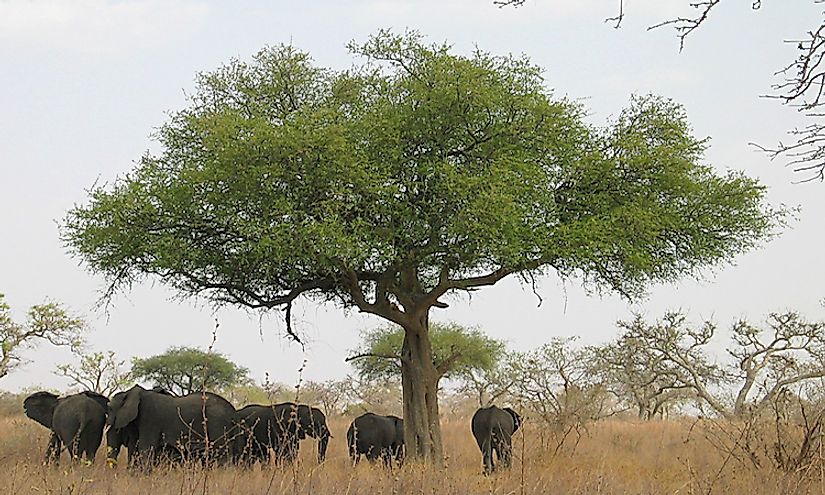Ecological Regions Of Cameroon

The Republic of Cameroon is located in West Africa and is bordered by Nigeria, Chad, Central African Republic, Equatorial Guinea, and the Republic of Congo. The country covers 475,442 km2 making it the world’s 53rd largest country. Cameroon exhibits all the major climates and vegetation of Africa. The country is divided into five geographical zones according to the climatic and vegetative features. Cameroon is home to several plateaus, mountains, hills, and forests, with four patterns of drainage. The country is divided into eight bioregions forming several ecological regions. The ecological regions of Cameroon include;
Atlantic Equatorial Coastal Forest
Atlantic Equatorial Coastal Forest covers the hills, mountains, and plains of the Atlantic coast of Cameroon and extends to Gabon, Democratic Republic of Congo, Angola, Equatorial Guinea, and the Republic of Congo. The ecoregion covers mainly the Sanaga River and is characterized by low undulating plains and hills. Atlantic Equatorial Coastal Forest receives an average rainfall of 2000 mm with limited seasonality. Temperatures range between 180C and 270C. Important river systems cross through the ecoregion forming extensive coastal deltas. The endemic species are concentrated in the mountain areas. The ecoregion supports over 4000 plant species, several mammals including the sun-tailed monkey, long-footed Shrew, fruit bat, gorillas, chimpanzees, buffalos, and bongo. Logging and poaching pose severe threats to the existence of this ecoregion including the protected areas
Cameroonian Highlands Forests
Cameroonian Highlands Forests cover the highlands and mountain areas around the border of Nigeria and Cameroon. The highest elevation within the ecoregion is Mount Oku at 3,011 meters above the sea level. The ecoregion experiences a mean temperature of 20oC due to the effects of high altitude while rainfall is about 4000 mm annually. Tree species in this ecoregion tend to be low compared to the non-woody species such as grasses. Some small mammal species are endemic to this region and they include stripped mouse, wood mouse, vlen rat, and mouse shrew. 40 species of amphibians are endemic while there are 27 species of birds in this ecoregion. Human activities such as agriculture, logging, and collection of firewood are increasingly fragmenting and degrading the ecosystem in this region.
Cross-Sanaga-Bioko Coastal Forests
Cross-Sanaga-Bioko Coastal Forests cover the lowlands and coastal forests of Cameroon with the forests above 800 m on Mount Cameroon and 900 m above on inland mountains. The topography is low on both the eastern and western margins but is rugged around the mountains. The region which falls in the humid tropics receives over 10,000 mm of rainfall annually with temperatures ranging from 15oC to 33oC. Some rivers including Sanaga and Cross Rivers, drain from this ecological region into the Atlantic Ocean. The region supports over 5,000 species of plant, several invertebrates including butterflies, and primates. The protected areas within Cross-Sanaga-Bioko Coastal Forests host several large mammals including gorillas and elephants. An extensive area of the ecoregion remains intact despite the effects of deforestation. The largest protected area within this ecosystem is the Korup National Park. Commercial logging and cultivation remain the major threats facing Cross-Sanaga-Bioko Coastal Forests.
Ecological regions of Cameroon continue to face the threats of logging, plantation agriculture, poaching, and collection of firewood. Illegal logging is rampant even in some of the protected areas. There is risk complete habitat loss if necessary laws are not enforced to curb these threats.
Ecological Regions Of Cameroon
| Ecological Regions of Cameroon (as per World Wide Fund for Nature) | Biome or Bioregion |
|---|---|
| Atlantic Equatorial Coastal Forests | Tropical and Subtropical Moist Broadleaf Forests |
| Cameroonian Highlands Forests | Tropical and Subtropical Moist Broadleaf Forests |
| Cross-Sanaga-Bioko Coastal Forests | Tropical and Subtropical Moist Broadleaf Forests |
| Mount Cameroon and Bioko Montane Forests | Tropical and Subtropical Moist Broadleaf Forests |
| Northwestern Congolian Lowland Forests | Tropical and Subtropical Moist Broadleaf Forests |
| East Sudanian Savanna | Tropical and Subtropical Grasslands, Savannas, and Shrublands |
| Guinean Forest-Savanna Mosaic | Tropical and Subtropical Grasslands, Savannas, and Shrublands |
| Mandara Plateau Mosaic | Tropical and Subtropical Grasslands, Savannas, and Shrublands |
| Northern Congolian Forest-Savanna Mosaic | Tropical and Subtropical Grasslands, Savannas, and Shrublands |
| Sahelian Acacia Savanna | Tropical and Subtropical Grasslands, Savannas, and Shrublands |
| Lake Chad Flooded Savanna | Flooded Grasslands and Savannas |
| Central African Mangroves | Mangrove |
| Lake Chad Basin | Nilo-Sudan Freshwater |
| Central West Coast Equatorial | West Coast Equatorial Freshwater |
| Northern West Coast Equatorial | West Coast Equatorial Freshwater |
| Western Equatorial Crater Lakes | West Coast Equatorial Freshwater |
| Sangha River | Congo Freshwater |
| Central Gulf of Guinea | Marine |











